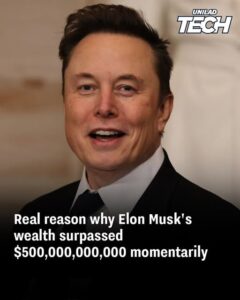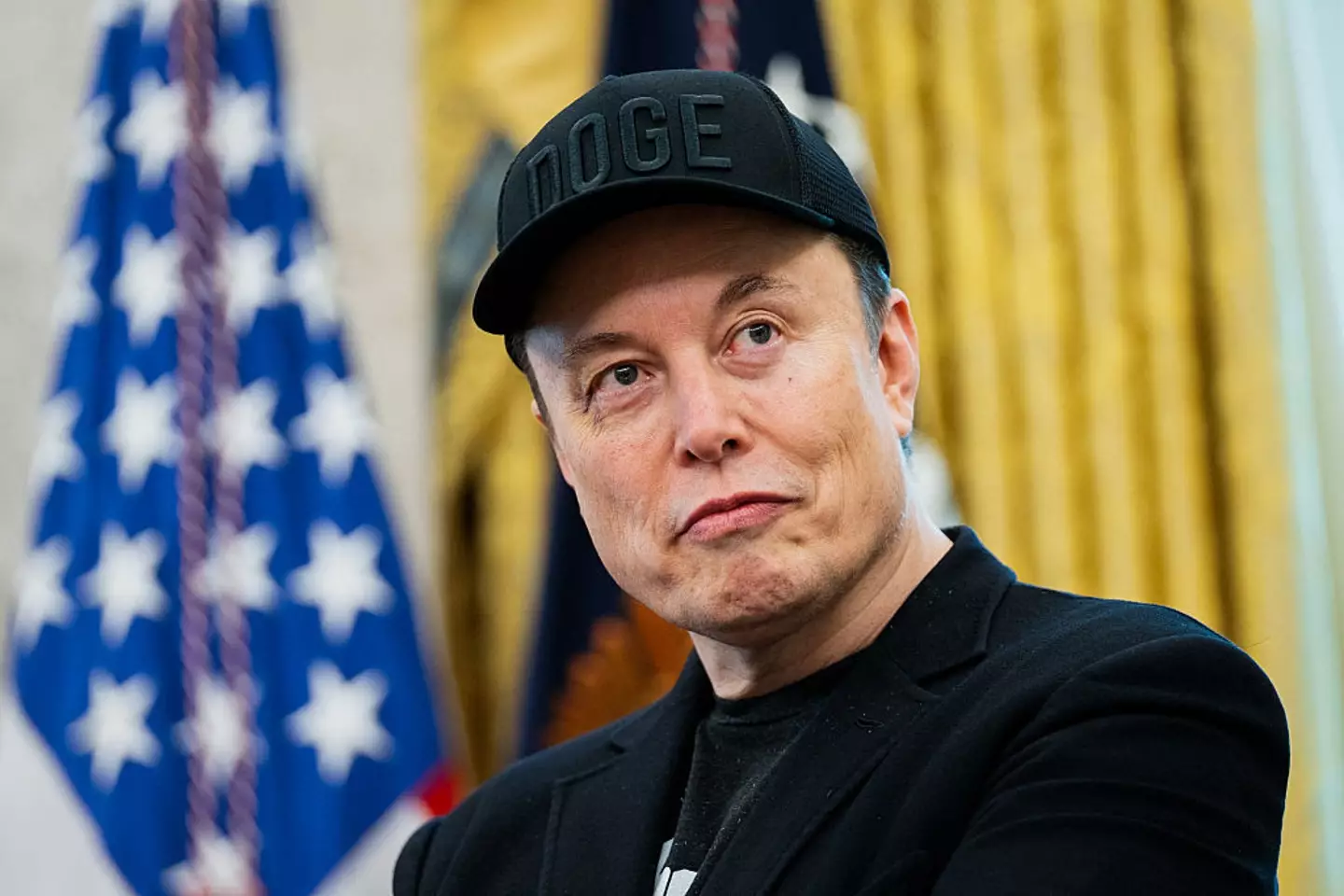f he’s not making history with his plans for Mars colonisation or political announcements on X, Elon Musk makes headlines for his wealth.
On Wednesday (1 October), the Tesla CEO briefly became the first person ever to reach a net worth of $500 billion (£371 billion), before falling back below that milestone just hours later.
Musk’s half-trillionaire status followed another rise in share price for his electric vehicle company.

Musk recently lost his title as the world’s richest person to Oracle founder Larry Ellison. (ALLISON ROBBERT/Contributor/Getty)
What is Elon Musk’s net worth?
By the end of the trading day, the SpaceX founder’s net worth had settled at $470 billion (£348.7 billion) – representing a single-day increase of $10.5 billion, according to Bloomberg’s Billionaires Index. Currently, his net worth stands at $482 billion (£359 billion).
To put that daily gain in perspective, 159 of the 500 richest individuals tracked by Bloomberg have a total net worth of less than $10 billion.
How did Elon Musk get his wealth?
The dramatic rise in Musk’s wealth is primarily driven by his stake in Tesla which saw a 3.3 percent increase in shares on Wednesday. The company’s stock has climbed more than 70 percent over the past six months, while reportedly recovering from a low point between March and April.
However, shares remain slightly below the record high reached in December 2024, despite ongoing challenges including weak sales in Europe and increasing competition from Chinese manufacturers.
Tesla shares were up an additional 0.7 percent in pre-market trading on Thursday (2 October), suggesting Musk’s wealth would continue to climb when US stock markets reopened. The South African owns approximately 12-13 percent of Tesla.
How does Elon Musk compare to other billionaires?
Musk recently lost his position as the world’s richest person to Oracle founder Larry Ellison for a short period, but has since extended his lead. The pair sit above Mark Zuckerberg and Jeff Bezos in the wealth rankings.

Tesla shares went up by 3.3 percent last Wednesday. (Sean Gallup/Staff/Getty)
The gap between them now stands at $121 billion, with Musk at $470 billion and Ellison at $349 billion (£259 billion) in second place.
Interestingly, that $121 billion difference is equivalent to the entire net worth of Bill Gates, the Microsoft founder who ranks 15th on the global rich list.
While Tesla stock is the primary driver of Musk’s wealth, he also owns several other companies, including SpaceX, The Boring Company, and xAI. Some of these private ventures have also seen their valuations increase this year, adding to his overall net worth.
Much of Ellison’s impressive wealth growth, nearly five decades after co-founding Oracle, comes from the company’s position at the forefront of AI development. This shift brought the tech mogul’s net worth from $107 billion in 2023 to $349 billion today.
Elsewhere in Oracle news, it was revealed that billions of dollars were spent in a Microsoft scandal.
The company allegedly hired investigators to sift through Microsoft‘s trash to discover that their rival was secretly funding academic groups and think tanks to influence public opinion.
Featured Image Credit: Chip Somodevilla / Staff / Getty

They say that what goes up must come down. While that’s all well and good, it’s not exactly what Elon Musk wants to hear when it comes to his Starlink satellites.
Away from buying up X, his ventures with Tesla, building tunnels with the Boring Company, and ambitions of heading for Mars with SpaceX, Elon Musk is again reaching for the stars with the aptly named Starlink.
While there have been some grumbles about the monthly cost of Starlink, the world’s richest man has continued his efforts to bring high-speed internet to all corners of the world.
Whether you’re up a mountain or stranded on a desert island, Starlink aims to give you access to the World Wide Web.
We’ve already covered potential problems with the Sun killing off Starlink satellites, while there are concerns about what their emissions are doing to the cosmos.
At the time of writing, there are over 8,400 satellites in orbit, although that number could soon be tumbling.
According to EarthSky, Starlink satellites are literally falling from the sky, coming down at an alarming rate of up to two a day.
The outlet explains how Harvard astrophysicist Jonathan McDowell has spotted fiery trails across the sky, with them coming from Starlink satellites.
The dreaded Kessler Syndrome is already clogging Low Earth Orbit, but as more companies compete for this area of space, McDowell suggests the number of satelittes dropping out orbit could be about to exponentially increase: “With all constellations deployed, we expect about 30,000 low-Earth orbit satellites (Starlink, Amazon Kuiper, others) and perhaps another 20,000 satellites at 1,000 km [620 miles] from the Chinese systems.
“For the low-orbit satellites we expect a 5-year replacement cycle, and that translates to 5 reentries a day. It’s not clear if the Chinese will orbit-lower theirs or just accelerate us to chain-reaction Kessler syndrome.”
The idea is that the more satellites that crash into each other, the more space debris there will be. The more space debris there is, the more the chances of further collisions increase.
With over 700 Starlink satellites potentially dropping out of orbit every year, they’re in danger of coming down faster than Musk’s company can get them up there.
Some have been incorrectly identifying falling satellites as meteors, although McDowell has explained how to spot the difference: “The easy ‘meteor vs. space junk’ discriminator is speed. A meteor from solar orbit, even a big fireball, lasts only a few seconds and is gone, whizzz. Space junk goes more like airplane angular speed (really faster than a plane, but higher so it cancels out) and may be overhead for a couple of minutes.”
Social media is flooded with videos of ‘space junk’ like Starlink satellites making dramatic displays in the sky, with questions about what can be done. Various factors are causing the satellites to reenter the Earth’s atmosphere, and even though operators can potentially boost them back up, we’re reminded of a 2022 incident when a solar storm doomed 40 recently launched Starlink satellites to crash back to Earth with a bump.
Featured Image Credit: Andrew Harnik / Staff / Getty

Elon Musk’s plan to send robots to Mars might not go as smoothly as he hopes, according to a leading robotics expert.
In an interview with Forbes, Christian Hubicki, head of the Optimal Robotics Laboratory at Florida State University, warned that the billionaire’s robots would likely become little more than scrap metal and plastic once left alone on the Red Planet.
“Humanoids fall down. They break. Their code crashes,” Hubicki explained. “Right now, humanoids aren’t reliable enough to be autonomous on Earth, let alone Mars.”
Musk has recently shifted Tesla‘s focus heavily toward robotics and artificial intelligence.
Last year, the SpaceX founder unveiled Tesla’s Robotaxi service, which he has promised investors will increase the company’s value by trillions of dollars.
However, the reasonably priced autonomous vehicles reportedly haven’t yet proven they can drive safely without human intervention.
Humanoid robots are the other major part of Musk’s vision. Tesla’s flagship robot is Optimus, and according to Musk, the company plans to build 100,000 units per month by next year.
But, a video demonstration of Optimus shared last month revealed several limitations, including the fact that it took an unusually long time to answer simple questions and glitched mid-sentence. Earlier videos saw the robot being able to poach an egg and dance.

Musk claims his Optimus robots would be sent to Mars by the end of 2026. (ALLISON ROBBERT/Contributor/Getty)
Musk has already incorporated these unproven humanoid robots into his famously ambitious plan to colonise Mars.
In April, he announced that Optimus robots would be sent to Mars aboard his Starship rocket by the end of 2026.
According to his plan, they would explore the planet’s surface and prepare the groundwork for human settlement. He’s recently restated this goal, and while acknowledging that ‘a lot needs to go right,’ provided a not-so-distant timeline.
“More likely, first flight without humans in ~3.5 years, next flight ~5.5 years with humans,” Musk posted in August. “Mars city self-sustaining in 20 to 30 years.”
While space agencies like NASA have deployed humanoid robots in space, the circumstances were very different, Hubicki explained to Forbes.
For NASA, the robots were ‘only on space stations where humans are already there to fix them.’
“Critically on the [International Space Station], humans are there to help and fix the robot when it inevitably falters,” Hubicki added. “On Mars, there are no humans to rescue it, and replacement parts are a nightmare to ship in.”
Hubicki claimed: “Without a major technological leap in humanoid reliability, an unaccompanied humanoid on Mars wouldn’t be functional for long.”
Featured Image Credit: JIM WATSON / Contributor / Getty



